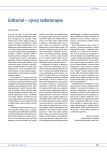Oncogenic Potential of Papillomaviruses
Authors:
B. Váňová; F. Golais
Authors‘ workplace:
Katedra mikrobiológie a virológie, PRIF UK Bratislava
Published in:
Klin Onkol 2013; 26(6): 399-403
Category:
Review
Overview
Papillomaviruses belong to a group of viruses with double-stranded DNA (dsDNA). These viruses are believed to induce benign as well as malignant tumour growth. Thanks to professor zur Hausen, the connection between the infection by human papillomaviruses (HPV) and cervix cancer was described in detail a few years ago. However, there exist certain types of HPV viruses, in which no association with malignancies was ever demonstrated. Hence, we can divide HPV into „high-risk“ (HR) and „low-risk“ (LR) group. Our work describes the life cycle of HPV, molecular mechanisms of oncogenesis and aims to compare HR HPV and LR HPV within these terms.
Key words:
viral cell transformation – oncogene protein E6 – oncogene protein E7 – E5 protein HPV-16 – „high-risk“ – „low-risk“
The authors declare they have no potential conflicts of interest concerning drugs, products, or services used in the study.
The Editorial Board declares that the manuscript met the ICMJE “uniform requirements” for biomedical papers.
Submitted:
28. 6. 2013
Accepted:
14. 7. 2013
Labels
Paediatric clinical oncology Surgery Clinical oncologyArticle was published in
Clinical Oncology

2013 Issue 6
Most read in this issue
- Syndrome of Vena Cava Obstruction in Oncology
- Is Preoperative Bone Scintigraphy in Early Stage of Breast Cancer T1N0 Indicated and Meaningful?
- Smoking and Breast Cancer
- The Assessment of Quality of Life of Patients at Oncological Clinic – Pilot Study
